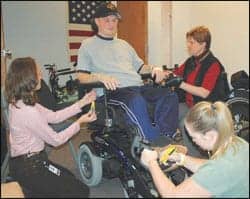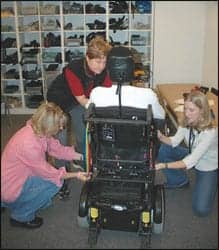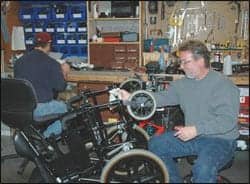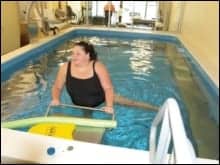 |
| Patient Rory Piecuch, center, oversees the wheelchair fitting team at work. They are, clockwise, from left, author Gail Gilinsky, OTR; Cindy Smith, PT; and Audrey Natalie, PT. |
Inpatients in their initial rehabilitation program, who have spinal cord injuries and need power wheelchairs for mobility, must be carefully evaluated over time. There are dozens of power wheelchairs, components, and options on the market. Decisions on equipment needs for an individual patient depend on a number of complex and interrelated factors. The patient’s home discharge environment, medical condition, cognitive and executive function abilities (safety, judgment, ability to learn), posture, skin integrity, body handling skills, vocational and avocational demands, lifestyle, caregiver needs, and transportation needs are all factors that contribute to the decision that power mobility is needed. These factors also help determine what type of power mobility and customization is necessary to maximize an individual’s independence and safety. Diagnosis alone is insufficient to recommend and order equipment. Once the decision is made that a person would benefit from power mobility, the evaluation process encompasses the following areas to determine the most appropriate system.
- Bases: It must be determined whether a rear-wheel, mid-wheel, or front-wheel drive system would work best in their environment and lifestyle. The need for different types of maneuverability indoors and outdoors and the patient’s ability to safely drive these systems contribute to this decision. The size of various bases may also be a factor for a person’s environment. The need for electronics that might provide programmability for performance in various environments must also be considered. Most major manufacturers have a variety of systems from which to choose.
- Drive control: If patients cannot operate the standard hand controls, further evaluation must be done to determine how they can safely and efficiently drive a power wheelchair and access any other switches that are needed for controlling components of the chair. Specialty controls, such as sip and puff (pneumatic) or chin drive, and switch access, such as head array, are just a few of the alternative drive control options that could be considered.
- Seating system: More often than not, it is the seating system that a patient is most concerned about when first considering a power wheelchair for comfort and endurance. The evaluation process must decide if a patient needs a standard upright rehab seat or a power seating system that tilts, reclines, or does a combination of the two. The primary criterion for selection of one or the other in the case of paralysis is the ability to do independent, safe, efficient, and timely weight shifts to protect the skin. Other considerations to determine the most appropriate seating system include pain, endurance, general mobility, age, weight, spasticity/tone, flexibility, upper extremity function, body type, functional tasks, and medical considerations, such as skin condition, bladder issues, and blood pressure.
- Cushions: Cushions are critical components of power chairs for people with paralysis. A cushion must be compatible with the type of chair and seating system, providing an appropriate surface for skin integrity, posture, and function.
- Posture and seating components: Positioning accessories, such as lateral trunk supports, hip guides, lumbar supports, specialty positioning belts, and customized backs, are just a few of the components that might be necessary to align one’s posture for maximal function and minimal postural compromise over time. Wheelchair users without the necessary postural and seating supports frequently develop posture problems that lead to skin breakdown or fixed deformities over time.
 |
| From left: Seating clinic therapists Tiffany Heck, OT; Cindy Smith, PT; and Kim Brown, OT, evaluate a patient’s power chair. |
During the evaluation process, it is optimal for the therapists to have an array of available demonstration (“demo”) wheelchairs that a patient can use to trial various manufacturers, systems, and components. At Craig Hospital, approximately 80 different power wheelchairs with various seating systems are maintained in the hospital “fleet” that therapists can select from for the evaluation process. Trials not only include continuous use within the hospital for mobility, but also are done during home and community outings to provide clinicians, the patient, and the caregivers the real-world information they need to validate clinical observations and conclusions about the base, drive, and seating systems. Classes are also provided for patients to increase their knowledge of options for power wheelchair bases and the manufacturers that produce them.
SEATING AND POSITIONING
An interdisciplinary seating and positioning clinic consisting of the patient and family, physical therapist, occupational therapist, and wheelchair specialist assist the treating team with the evaluation and recommendations, fitting of wheelchairs, and completing order forms. This is an opportunity to look more closely at what is working for a patient’s long-term posture and seating needs. Final decisions on both the wheelchair base and seating systems are made based on the collective information obtained during the trial period, and can involve wheelchair components from multiple manufacturers. It is important to be able to trial as many of the wheelchair components as possible prior to ordering to assure the proper fit and outcome of each item. The wide array of available seating and positioning components for the power wheelchairs contributes to the customization and individualized fitting necessary to make the system safe and functional for each person.
Insurance policy benefits and insurance durable medical equipment (DME) contracts can widely vary, are individualized, and can positively or adversely affect the type of wheelchair ordered and its components. Rehabilitation providers involved with power mobility should have effective relationships with clinical case managers and insurance carriers to help procure DME for the patient that is medically necessary, functionally appropriate, and cost-effective. For individuals who require power chairs, it is medically necessary for them to have a backup manual wheelchair in the event of medical emergencies, power chair breakdowns, or changing transportation needs.
 |
| Repair technicians Todd Branish, left, and Tim Case maintain Craig Hospital’s wheelchair fleet. |
Power wheelchairs should optimally be delivered, fitted and programmed prior to discharge home from initial rehabilitation. This prevents equipment having to be shipped and assembled in patients’ homes or local outpatient settings. The entire process prior to inpatient discharge requires the writing of the prescription, insurance authorization, ordering, delivery, assembly, final fitting, patient trial, patient and family training, and identification of local vendors. The final fitting includes the patient’s and family’s ability to use the equipment, ensuring that the chair fits properly and comfortably for function, skin integrity, and posture. Fitting time also includes programming the electronics of the wheelchair (if applicable) for the type of environment the patient will encounter. Patient and family training in the operation and maintenance of the chair is critical, and is typically offered in individual and group wheelchair care and maintenance classes. Part of the predischarge protocols is to assist families who may live some distance away to locate and communicate with vendors who will be able to assist them with service, repairs, warranty issues, part replacements, and other needs once they return home. It is felt that the more patients and their caregivers are involved and educated in the power wheelchair process, the more successful and accepting of their equipment they’ll be.
REPLACEMENT POWER WHEELCHAIRS
Typically, power wheelchairs will last 5 to 7 years, depending on individual usage, and how much care and maintenance the individual provides for the system. Changes in a patient’s medical conditions can significantly impact how long a specific wheelchair is appropriate for them.
An individual’s subsequent wheelchairs may or may not be significantly different from his or her original chair. Neurological changes, aging issues, functional changes, and changes in weight, posture, endurance, mobility, and skin and shoulder integrity all can play a role in the continued evaluation process. For example, an individual might need to go from a standard seating system to a power recline seating system because of decreased shoulder integrity. Aging with paralysis often leads to overuse of the shoulders for necessary mobility, which can eventually lead to inability to perform independent weight shifts and transfers in a standard chair. Fortunately, most current power chairs now have the ability to have interchangeable seating systems.
Individuals requiring a new chair over time should access or reaccess an experienced interdisciplinary team who specializes in high-level seating and mobility. Being able to understand and appreciate the implications of all the clinical and functional factors is key to determining the most appropriate power wheelchair. Typically, over time, wheelchair users require more complex evaluations and recommendations, not less complex.
Funding of power wheelchairs over the long term is also a complex task, depending on patient needs, the funding source, and where the patient resides. For many patients, Medicare is often involved. Medicare changed its coverage criteria, documentation, and prescription requirements for power mobility devices (PMD) in May 2005 (see Medicare Physician Resource Guide in Web Resources). Professionals responsible for ordering wheelchairs need to be skilled at understanding public and private insurance benefits and articulating the medical necessity and value to the patient of the DME they are prescribing. This includes the features and benefits of the equipment they are ordering in terms of safety, function, and cost-effectiveness.
In summary, assisting people with disabilities with their power mobility needs is complex and sophisticated. It is a highly specialized practice, which requires a skilled and experienced interdisciplinary team who know the patient’s medical condition, functional abilities, and disabilities; the array of available equipment options in the marketplace; and the nuisances involved with dealing with various funding sources.
Gail Gilinsky, OTR, ATP (), is an occupational therapist who has worked at Craig Hospital for 30 years. Gilinsky was previously director of the OT department, and has specialized in power mobility since 1980.
Pat Cody, RTS, ATS (), has specialized in power mobility since 1972, is a consultant to Craig Hospital, and is the Rehab Tech Supplier for ATG, Denver.
Kenneth R. Hosack, MA (), has worked in the field of spinal cord injury and traumatic brain injury for 30 years. He is director of provider relations at Craig.
WEB RESOURCES
- Choosing the right power chair configuration. Available at: www.mobilitymgmt.com/articles/67383. Mobility Management. Accessed September 26, 2008.
- Seating evaluation and wheelchair prescription. Available at: www.emedicine.com/pmr/topic156.htm. eMedicine. Accessed September 2008.
- Medicare physician resource guide: coverage criteria and documentation requirements for power mobility devices. Available at: [removed]www.pridemobility.com/physicianeducation/Physician_Medicare_Resource_Guide.pdf[/removed]. Pride Mobility. Accessed September 26, 2008.





